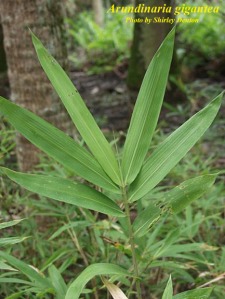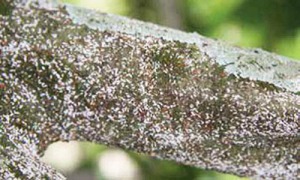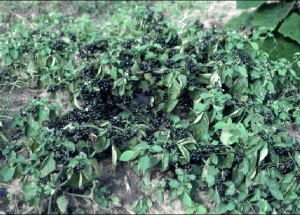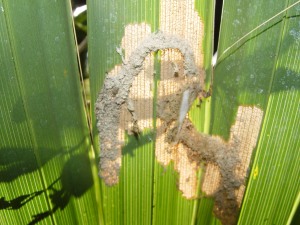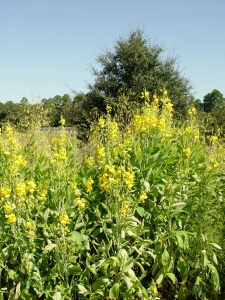A: You will only be able to manage those reeds popping up on your property unless you have your neighbor’s permission. If you are having a problem then your neighbor might be frustrated too. Working together would be ideal. It may be hard to believe but bamboo is really just a giant type of perennial grass. Most people use it as a hedge for privacy or keep it in large planters to enhance a patio. There are numerous varieties of bamboo ranging in heights from 1 to 70 feet tall. The United States has only one native species, called cane or canebrake bamboo. This native bamboo generally behaves itself and does not become a nuisance in our wildlife areas or our neighbor’s yards. However, there are dozens of imported bamboos which are highly invasive and exceedingly difficult to control. These invasive varieties have large underground rhizomes used to store food for the plant. Non-native bamboo is extremely difficult to control as it requires killing all the rhizomes. Bamboo plants typically build extensive rhizome networks underground. This makes management of bamboo intensive and difficult because all it takes is one rhizome cluster and the bamboo will return. You can try mowing the canes a couple of times a week, similar to lawn grass, and this will reduce the amount of chlorophyll available to produce food. Regarding any chemical applications we would recommend using glyphosate in the form of a 5% solution or 6 ounces per gallon. The University of Florida recommends using glyphosate with a 41% concentration of the active ingredient. While some studies have shown the active ingredient imazapyr is more effective on bamboo than glyphosate, this product can leach into the soil and damage surrounding plants such as trees, shrubs and other perennials. Therefore we would not recommend applying this product to the bamboo on your property. Unfortunately, it will most likely take between three and four applications of glyphosate to control this pest. This is an important message for us when adding plants from other countries to our landscapes. If you do not want to use chemicals you can put a barrier between the bamboo and your property. Dig a trench approximately 36 inches deep. Use rolls of fiberglass or 60 mil polypropylene in the trench. Leave about 2 inches of the barrier above the soil to discourage rhizomes from growing over the top of the barriers. It sounds extreme but it does work.
Monthly Archives: November 2015
Q: What is this white powdery stuff on the trunk of my citrus tree?
A: This pest is called citrus snow scale and believe it or not – it is an insect. Citrus snow scale attaches to the trunk and sometimes when populations are extremely high, it can be found on leaves and other parts of the citrus tree. The insect feeds on the plant juices diminishing the nutrients available to the tree. The insect reproduces in large numbers to cover the trunk tissue where it resembles “snow.” Armored scales are distinguishable from soft scales by the removable cover or ‘armor’. As crawlers, the females of snow scale insert their long mouthparts into suitable hosts and never move again. The immature males become immobile once they begin feeding and remain immobile until they emerge as winged adults. In severe infestations, the bark of the trunk or limb can split, making the tree vulnerable to fungal disease. Citrus snow scale has a tendency to pile up on top of one another making chemical application difficult to reach the bottom layer. Consider brushing the stems and branches with a soft toothbrush or larger soft brush first to remove some of the layers of the scale. Then apply insecticidal soap or all season horticulture oil. More than one application will be required.
Q: When do I prune bamboo?
A: No matter what time of year, you can prune out dead canes. That rule also applies to any tree or shrub. Some people like a dense thicket while others like a more open and airy look. Generally, we recommend taking out any canes over seven years old. You can use a pruning saw, just be sure it is sharp and cut the cane at ground level. Prune bamboo most any time of year except when it is producing new shoots as it would be easy to damage the new growth
Q: What can you tell me about the common garden huckleberry?
A: The University has a publication on the garden huckleberry in the genus Solanum. It is an edible form of the common nightshade weed plant. Parts of many nightshade plants can be poisonous as they can contain high levels of poisonous alkaloids. Because of its close relationship with the nightshade family there has been some confusion about ingestion of the fruit of this plant. It is always best to avoid eating fruit or berries from shrubs or trees in the forest unless you are well acquainted with the plant. However, garden hackberry is safe to eat. Garden huckleberry is also known as quonderberry, wonderberry, sunberry, moralle, morella, petty morel, solanberry, black berried nightshade, and houndsberry. The reference to black berried nightshade is very similar to deadly nightshade which is poisonous. The garden huckleberry plant looks similar to a pepper plant growing to about 2½ foot tall. The berries are green when immature and black when mature, resembling wild huckleberries. Berries are filled with a greenish pulp, mixed with small pale yellow seeds. The berry flavor is similar to a bitter tomato, which does not sound appealing to me. The berries can be used for making preserves, pies or cooked dishes. Garden huckleberry has been grown in gardens successfully all around Florida. Sow seeds about 1-inch deep at a time, which will allow the plant to grow and mature in warm weather since it is susceptible to cold injury. Space plants 12 to 24 inches apart. It may be transplanted, and a start may be obtained from a cutting. It has few pest problems.
Q: What is wrong with my palm frond?
A: First conspicuous sign of infestation is large quantities of “frass” which is the fibrous, excrement from the larval form of a tiny moth called the Palm leaf skeletonizer, Homaledra sabalella. This moth feeds mostly on tissue between veins or ribs of lower leaf surfaces of many palms to it will be difficult for any chemical to reach the larvae. This is the reason we do not recommend any heavy broad spectrum pesticides. The Palm leaf skeletonizer will also feed on leaf stems, disrupting vascular tissue and causing death of entire frond. Female moths lay batches of 36 or more eggs glued to the surface of older palm leaves and covered with brown, papery material. The larvae mine in groups on both the upper and lower surfaces of older leaves, under webs of silk. Excrement from the larvae is deposited on top of the silk. Pupation takes place in the larval mines. There may be up to five generations per year. Cutting and bagging or burning infested leaves is an effective method of control.
Q: What is this large wildflower growing in my yard?
A: Thanks for bringing in a specimen of this large plant. It most likely belongs to the genus, Crotalaria. There are approximately 600 species of Crotalaria worldwide. I believe your plant is a Showy rattlebox. If it is Showy rattlebox, Crotalaria spectabilis, then it is native to southern Asia but now can be found worldwide. In the United States it occurs from Missouri to Virginia south to Florida and Texas. Showy rattlebox can reach heights up to six feet with bright showy pea-like flowers up to an inch wide. These flowers will bloom in large clusters along a tall stalk which is where it gets the name “showy.” The rattlebox name comes from the sound the seed makes in the pod once it has become dry and mature. This annual legume is native to Indomalaysia and was introduced to the United States as a soil building cover crop on sandy soils. Showy rattlebox can be poisonous to livestock, particularly when seeds are consumed. Like other Crotalaria species, showy rattlebox contains pyrrolizidine alkaloids, which is present in greatest quantity in the seeds. All livestock including poultry are subject to poisoning. Symptoms include photosensitization and liver disease within a few days to 6 months following consumption. Showy rattlebox has been a problem for farmers. Since it is an annual legume, it produces large numbers of seed as this is its only means of propagation. Showy rattlebox prefers open and disturbed sites generally because these sites tend to be poor nutritionally.

